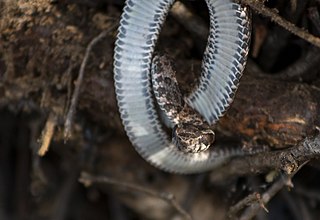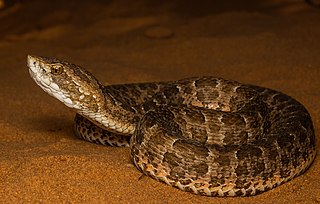
Bothrops atrox — also known as the common lancehead, fer-de-lance, barba amarilla and mapepire balsain — is a highly venomous pit viper species found in the tropical lowlands of northern South America east of the Andes, as well as the Caribbean island of Trinidad. No subspecies are currently recognized.

Bothrops leucurus, commonly known as the whitetail lancehead or the Bahia lancehead, is a species of venomous snake, a pit viper in the family Viperidae. The species is endemic to Brazil. There are no subspecies which are recognized as being valid. A female owned by youtuber Venom Central is over six feet long.
Stefania roraimae is a species of frog in the family Hemiphractidae. It is endemic to Guyana. Its type locality is Mount Roraima; it is also known from Mount Ayanganna and Mount Wokomung. It presumably occurs in the adjacent Venezuela and Brazil too.

Bothrops Insularis, commonly known as the Golden Lancehead, is a highly venomous pit viper species found exclusively on the Ilha da Queimada Grande, off the coast of São Paulo state, in Brazil. The species is named for the light yellowish-brown color of its underside and for its head shape that is characteristic of the genus Bothrops. No subspecies of Bothrops insularis are currently recognized. It is one of the most venomous snakes in Latin America.
Bothrops pirajai is a species of venomous snake, a pit viper in the subfamily Crotalinae of the family Viperidae. The species is endemic to Brazil. There are no subspecies that are recognized as being valid.
Bothrocophias colombianus, commonly known as the Colombian toad-headed pitviper, is a species of venomous snake in the family Viperidae. It is endemic to South America.

Bothrops cotiara is a species of venomous snake in the family Viperidae. It is endemic to Brazil and Argentina.

Bothrops erythromelas, commonly known as the Caatinga lancehead or the jararaca-da-seca, is a species of venomous snake in the family Viperidae. It is endemic to Brazil.

Bothrops fonsecai, also known commonly as Fonseca's lancehead, is a species of venomous snake in the family Viperidae. The species is endemic to Brazil.

Bothrops lutzi, the Cerrado lancehead, is a species of venomous snake in the family Viperidae. The species is endemic to Central eastern Brazil. Within the country, it can be found in states such as: Minas Gerais, Bahia, Goiás, Tocantins, Piauí, and Ceará. The South American viper has sparked an interest from the scientific community due to its venom, as it is believed to have some therapeutic potential. Scientists have found that the venom carried by B. lutzi has antibacterial and antiparasitic effects, which can help fight against microbial resistance by medical patients, as well as parasitic diseases like leishmaniosis and Chagas’ disease.

Bothrops itapetiningae, or the São Paulo lancehead, is a species of venomous snake in the family Viperidae. It is endemic to Brazil.

Bothrops jonathani, known commonly as Jonathan's lancehead or the Cochabamba lancehead, is a species of venomous snake, a pit viper in the family Viperidae. The species is endemic to South America.

Bothrocophias lojanus, also known commonly as the Lojan lancehead in English, and macanchi or macaucho in Spanish, is a species of venomous pit viper in the subfamily Crotalinae of the family Viperidae. The species is native to northwestern South America.
Bothrops marajoensis, or the Marajó lancehead, is a species of venomous snake in the family Viperidae. It is endemic to Brazil.

Bothrocophias microphthalmus, or the small-eyed toad-headed pit viper, is a species of venomous snake in the family Viperidae. The species is endemic to northwestern South America.

Bothrops moojeni, commonly known in English as the Brazilian lancehead, is a species of venomous snake in the family Viperidae. It is a pit viper endemic to South America.

Bothrops pictus, commonly known in English as the desert lancehead, is a species of venomous snake in the family Viperidae. The species is endemic to South America.

Bothrops sanctaecrucis, or the Bolivian lancehead, is a species of venomous snake in the family Viperidae. It is endemic to South America.

Bothrops venezuelensis, or the Venezuelan lancehead, is a species of venomous snake in the family Viperidae. It is endemic to South America.

Snakebite envenomation is considered a public health problem in Latin America, with an estimated 70,000 cases annually, but due to underreporting, these numbers may be even higher.
















